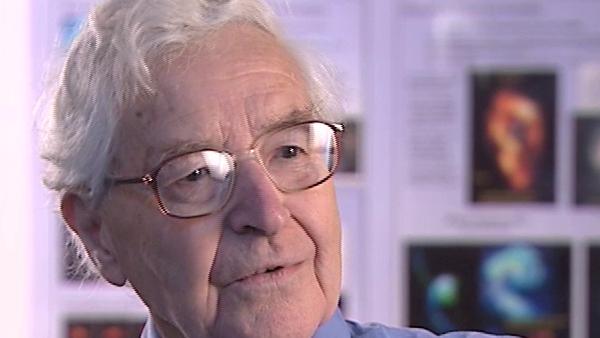NEXT STORY

Tracking the solar atmosphere
RELATED STORIES

NEXT STORY

Tracking the solar atmosphere
RELATED STORIES


|
Views | Duration | |
|---|---|---|---|
| 1. A wonderful early life | 1 | 259 | 02:17 |
| 2. A career-changing encounter | 197 | 01:38 | |
| 3. How the war helped to focus my mind | 132 | 04:57 | |
| 4. Getting my foot into research | 129 | 04:17 | |
| 5. Advancing the field of radio astronomy | 98 | 03:31 | |
| 6. Calculating the velocity of ionospheric wind | 138 | 03:14 | |
| 7. Building antennas | 101 | 01:44 | |
| 8. Tracking the solar atmosphere | 87 | 02:16 | |
| 9. Scintillataion, quasars and pulsars | 1 | 109 | 05:46 |
| 10. Being the first to measure solar wind | 82 | 08:55 |

The group was a very coherent group that Martin Ryle had then, and you didn't just do one thing: you had to help with everything because the equipment, it's not like nowadays where you… where you design an equipment and then you write reports on it and you have committees breathing down your neck to approve it and you get the funding and so on. In those days you… the university had the funds, actually – we weren't spending much money to build whatever we wanted to build. And Martin Ryle was building his own radio telescopes for the first surveys and everybody had to help in those things. I had… I spent a lot of time designing dipoles for the feeder arrays that went in the first… the first 2C survey which had four big reflectors. And if you designed something you had to make it work, so I spent a whole lot of time climbing up and down antennas and matching, impedance matching and so on, and all that was quite independent from the… from the research I was actually doing on the Sun's atmosphere and the ionosphere.
But it was amazingly good training to have such hands-on experience of antennas and it gave me the confidence to actually build things and make them work on a larger scale, which eventually led on to the pulsar work, of course. I mean, I'd never have built that antenna. But that came quite a long way… quite a long way down the line. I was building my own antennas as well as building antennas, helping to build antennas for Martin Ryle, and that experience all linked together to make me very much a hands-on person.
Antony Hewish (1924-2021) was a pioneer of radio astronomy known for his study of intergalactic weather patterns and his development of giant telescopes. He was awarded the Nobel Prize for Physics in 1974, together with fellow radio-astronomer Sir Martin Ryle, for his decisive role in the groundbreaking discovery of pulsars. He also received the Eddington Medal of the Royal Astronomical Society in 1969.
Title: Building antennas
Listeners: Dave Green
Dave Green is a radio astronomer at the Cavendish Laboratory in Cambridge. As an undergraduate at Cambridge his first university physics lecture course was given by Professor Hewish. Subsequently he completed his PhD at the Cavendish Laboratory when Professor Hewish was head of the radio astronomy group, and after postdoctoral research in Canada he returned to the Cavendish, where he is now a Senior Lecturer. He is a Teaching Fellow at Churchill College. His research interests include supernova remnants and the extended remains of supernova explosions.
Tags: Martin Ryle
Duration: 1 minute, 44 seconds
Date story recorded: August 2008
Date story went live: 25 June 2009